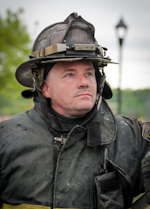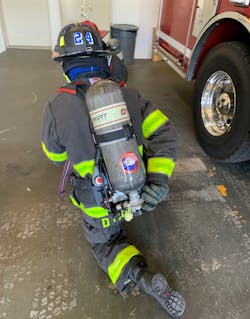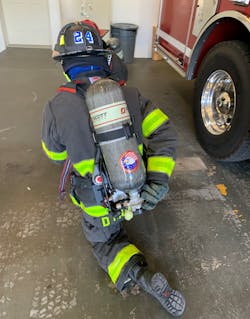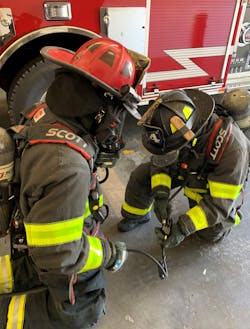Essential SCBA Skills Every Firefighter Should Revisit
Complacency is the evil that firefighters battle each day they pull on a pair of boots. Slower fire run numbers, more time between fires and constant EMS runs are some of the many excuses we use to let the small things slip through the cracks when it comes to skill proficiencies.
Whether it be a nozzle, the irons, or any other piece of equipment that we don’t have ready, these are just a few pieces of equipment that are mandatory to be functioning at 100 percent.
Your SCBA is the one tool you use on every fire, no matter the size. Just pull up any social media firefighter feed and there is little doubt that you will find a post showing the gauge of an SCBA not filled to capacity. While this is a great reminder to always have a full cylinder, it is also a time to remember that having a full cylinder is not the only thing you should check on your SCBA.
Let’s take a look at the four essential points that should be performed each time you check, service or place a SCBA back in service. Working through these four functions will take a focused time and effort to improve. Patience will be needed as you soon realize that we have become “rusty” with our skills. Start with complete vision and dexterity while building to the ultimate goal of functioning without both. As you become more confident in each skill, begin to add stress in the form of noise, disorientation and a sense of urgency. These functions can pay huge dividends on the fireground in just a short amount of time.
PASS alarm
Gone are the days of the non-integrated PASS alarms and yet their importance has never changed. Essential to all fireground operations is a properly functioning PASS alarm. During your check to return the SCBA to service, all PASS alarms should be activated by allowing limiting motion until they activate and then silence them with your gloves on. Once you have reset it, test the manual PASS alarm activation. How many of us have been to fire scenes where PASS alarms activate? This should not happen unless it is an emergency, period.
The essential part of this mundane routine is the way in which you perform the check. By taking the time to don the SCBA, buckle all the buckles and tighten the shoulder straps, you put it in the general location it will be in during the fire. From this position, take your right and left hand to function the manual activation, silence and reset functions. Using the off hand is not impossible but it takes repetition to become proficient. Getting reps in during checks will add to the amount of time spent making sure you can call for help when needed and silence a non-emergent activation.
Buckle your waist belt
It should not even have to be mentioned in the pages of Firehouse to buckle your waist belt. Yet, it is seen every day on the fireground. Use the time spent during checks and training to don the SCBA, crawl around with your waist belt unbuckled and see what your thoughts are. Between the movement, the instability and the buckles getting snagged by nearby objects, it should be a reminder why we buckle them. Imagine crawling inside a burning structure and noticing your waist belt is now stuck on an object. Would you pull off gloves to remedy this issue? Many fireground oversights must be fixed before going inside burning buildings.
If not the personal reminders of buckling the belt, we should pull from the experiences of others. One incident that comes to mind is a Delaware firefighter who fell through the floor with his waist belt unbuckled. His rescuers described the difficulty in removing him, because when they pulled up on his SCBA they pulled it off his back. This case should remind us all that if for no other reason than to help other firefighters save us, we need to ensure it is closed.
Accessing your Universal Airway Connection
When was the last time you had to gain access to your Universal Airway Connection (UAC) designed for RIT operations? I hope the answer to that question is never, but this leads to the fact of we need repetitions in its use. Performing this essential skill should be done in teams of two.
First, deploy the UAC, then each firefighter should use it to hook into their partner’s SCBA or RIT kit. The second scenario should have each firefighter access their partner’s UAC and use it to connect their SCBA and then connect the partner’s SCBA. It is not as easy as you might think, and that’s just in environments without obstructed or limited vision. Begin this review with full vision and progress to complete blackout conditions.
Sharpening survival skills
Without a doubt this is the number one skill every firefighter should practice. Working in high stress, super-heated environments can lead to many uncomfortable situations in relation to your SCBA. Whether it be a dislodged facepiece, an SCBA ensnared in wire or an inadvertent cylinder valve closing, firefighters must be able to recognize the issue and adjust for it in a timely manner while carrying out mission-critical tasks.Possibly the most important of the mentioned emergencies is the dislodged facepiece. Getting hit by a passing firefighter or a hose stream can cause shear panic. Drilling on this scenario can help lead to a successful correction of the issue. Start with a facepiece that has been knocked just to the side of your face where the seal has been broken and air is free flowing. Start with sliding it into place with no hood on and full dexterity. Progress from this point to wearing a hood, gloves and blacked-out facepiece. This may seem like an unlikely event, but one could imagine how stressful it would be to get your facepiece back on without exposing yourself to too many toxins while you’re already in a panic.
Pack removal should be another mandatory skill to help you remove an entanglement problem. With the large amount of cables for internet, phones and other connectivity, firefighters must be able to clear those obstacles quickly. The most drastic of these will be the partial removal of the SCBA. Key points of this skill are to control the regulator side of the SCBA and remove as little of the apparatus as possible to ensure quick donning. Leaving the waist belt connected and removing only one arm should be the start of the skill. This will minimize the potential for loss of control of the SCBA. Finish the skill set with complete removal and cutting simulated wires that have been entangled.
The final emergency to review is the cylinder valve that has not been opened all the way. No other feeling on the fireground is worse than a collapsing facepiece with zero airflow from it. It is essential that all firefighters have a quick system to recognize and adjust for this emergency quickly. Start by checking the regulator and emergency bypass to ensure they are in the proper positions. This initial effort should be accomplished while using the other hand to reach back and ensure the valve is completely open. Most SCBA have a safety system that prohibits turning it completely off, but if it is not completely opened, you can experience a failure. These systems need to be in place, for if the real situation happens, it will be high stress, as you cannot breathe. Muscle memory needs to be automatic in the system of checks. Start practicing this skill with the SCBA off your body with both left and right hands. Gaining the “feel” for the valve will allow you to make quick work of a valve that is not completely opened in a stressful situation. Tasks like these seem simple, but add in the stress of these incidents happening during fireground operations and they can become amazingly difficult.
Conclusion
Without a doubt your SCBA is going to be used on the next fire. We should take the time to review these essential skills each and every day we walk into the station. From the small volunteer departments in rural USA to the big cities, it is up to you to stay sharp and keep complacency out of your way. Use the time in checking and drilling to ensure that your SCBA skills are prepped and ready for your next fire! You never know when ole’ Mr. Murphy may show up and you need to adjust, adapt and overcome a misstep to continue our mission of protecting life and property.
Practice does not make perfect. Practice makes permanent. Reviewing all your fireground skills can seem like a colossal task. If you take the time to break them down and utilize the short spurts of time such as checks and returning it to service you can break those tasks into manageable chunks. Start on your next tour, drill night or in your spare time. Constant reviewing of the most basic of functions can and will save your life in the arena of firefighting. Don’t let that complacency creep into your world. Battle it by staying sharp on all your SCBA skills.

Ryan Pennington
RYAN PENNINGTON is a 22-year veteran of fire/EMS. He currently serves as a captain/paramedic with the Charleston, WV, Fire Department, where he has served for the past 12 years. Pennington has lectured and trained thousands of firefighters across the United States and internationally at conferences, including Firehouse Expo and Firehouse World, and has been published in many fire service publications.








